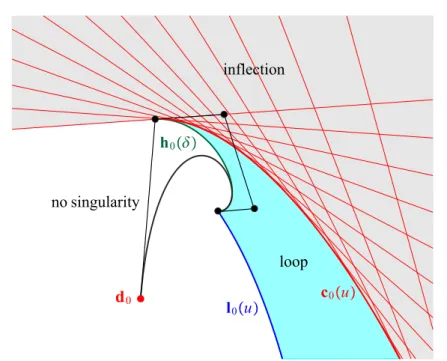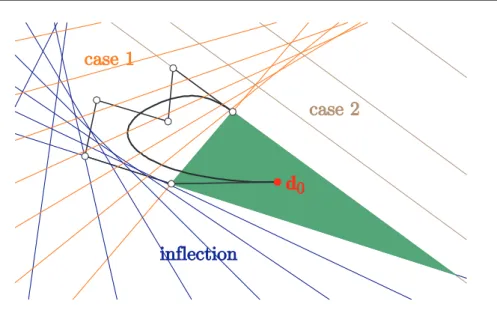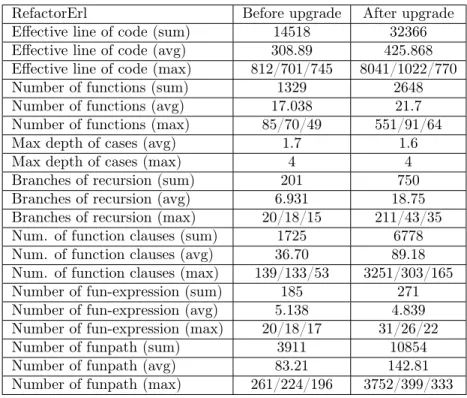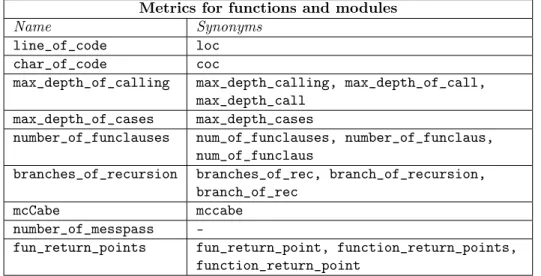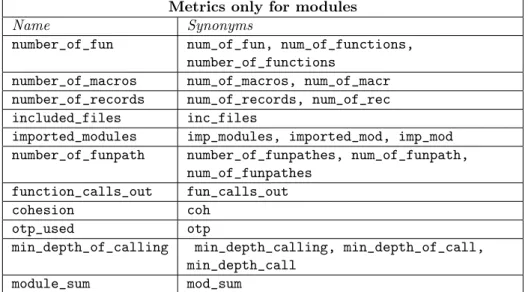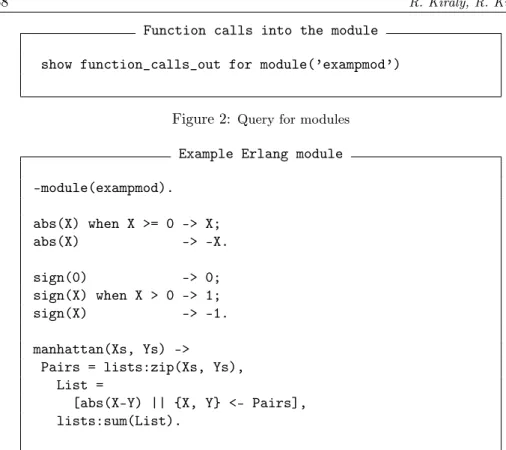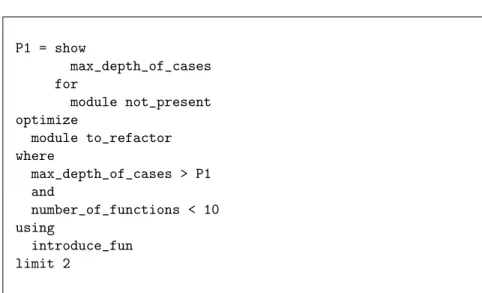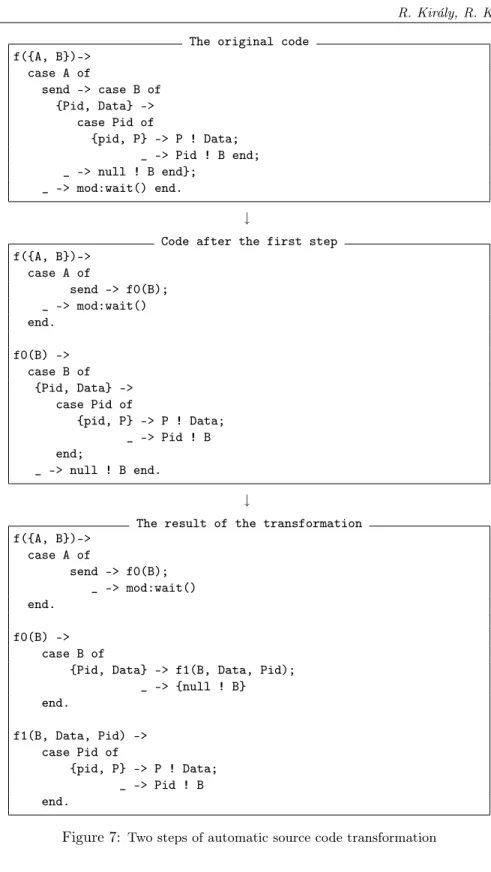Contents
Cheikhna Hamallah Ndiaye, Gane Samb LO, On general strong laws of large numbers for fields of random variables . . . 3 Nour El Houda Djaa, Seddik Ouakkas, Djaa Mustapha, Harmonic
sections on the tangent bundle of order two . . . 15 Gogola, J., Mačaj, M., Visnyai, T., OnIc(q)-convergence . . . 27 Juhász, I., A convexity test for control point based curves . . . 37 Kazemi, A.P., Sheikholeslami, S.M., Volkmann, L., The Roman(k,k)-
domatic number of a graph . . . 45 Király, R., Kitlei, R., Metrics based optimization of functional source
code . . . 59 Kozsik, T., Pataki, N., Szűgyi, Z., C++ Standard Template Library by
infinite iterators . . . 75 Kunkli, R., Biarc analysis for skinning of circles . . . 87 Mátyás, F., Szalay, L., A note on Tribonacci-coefficient polynomials . . . 95 Mishra, P. K., Mishra, K. S., Mishra, A., A clustering algorithm for
multiprocessor environments using dynamic priority of modules . . . 99 Moody, D., Arithmetic progressions on Huff curves . . . 111 Nyul, G., Rauf, B., Upper bounds on van der Waerden type numbers for
some second order linear recurrence sequences . . . 117 Zékiri, A., Bencherif, F., A new recursion relationship for Bernoulli Num-
bers . . . 123 Methodological papers
Budai, L., GeoGebra in fifth grade elementary mathematics at rural schools 129 Egri-Nagy, A., “How to solve it?” – The tsumego session . . . 137 Erdélyi, K., Teaching of monitoring software . . . 147 Nagy-Kondor, R., Technical mathematics in the University of Debrecen . . 157
ANNALESMATHEMATICAEETINFORMATICAE38.(2011)
TOMUS 38. (2011)
COMMISSIO REDACTORIUM
Sándor Bácsó (Debrecen), Sonja Gorjanc (Zagreb), Tibor Gyimóthy (Szeged), Miklós Hoffmann (Eger), József Holovács (Eger), László Kozma (Budapest), Kálmán Liptai (Eger), Florian Luca (Mexico), Giuseppe Mastroianni (Potenza), Ferenc Mátyás (Eger), Ákos Pintér (Debrecen), Miklós Rontó (Miskolc, Eger), László Szalay (Sopron), János Sztrik (Debrecen, Eger), Gary Walsh (Ottawa)
International journal for mathematics and computer science Referred by
Zentralblatt für Mathematik and
Mathematical Reviews
The journal of the Institute of Mathematics and Informatics of Eszterházy Károly College is open for scientific publications in mathematics and computer science, where the field of number theory, group theory, constructive and computer aided geometry as well as theoretical and practical aspects of programming languages receive particular emphasis. Methodological papers are also welcome. Papers sub- mitted to the journal should be written in English. Only new and unpublished material can be accepted.
Authors are kindly asked to write the final form of their manuscript in LATEX. If you have any problems or questions, please write an e-mail to the managing editor Miklós Hoffmann: hofi@ektf.hu
The volumes are available athttp://ami.ektf.hu
ANNALES
MATHEMATICAE ET INFORMATICAE
VOLUME 38. (2011)
EDITORIAL BOARD
Sándor Bácsó (Debrecen), Sonja Gorjanc (Zagreb), Tibor Gyimóthy (Szeged), Miklós Hoffmann (Eger), József Holovács (Eger), László Kozma (Budapest), Kálmán Liptai (Eger), Florian Luca (Mexico), Giuseppe Mastroianni (Potenza), Ferenc Mátyás (Eger), Ákos Pintér (Debrecen), Miklós Rontó (Miskolc, Eger), László Szalay (Sopron), János Sztrik (Debrecen, Eger), Gary Walsh (Ottawa)
INSTITUTE OF MATHEMATICS AND INFORMATICS ESZTERHÁZY KÁROLY COLLEGE
HUNGARY, EGER
HU ISSN 1787-6117 (Online)
A kiadásért felelős az Eszterházy Károly Főiskola rektora Megjelent az EKF Líceum Kiadó gondozásában
Kiadóvezető: Kis-Tóth Lajos Felelős szerkesztő: Zimányi Árpád Műszaki szerkesztő: Tómács Tibor Megjelent: 2011. december Példányszám: 30
Készítette az
Eszterházy Károly Főiskola nyomdája Felelős vezető: Kérészy László
Annales Mathematicae et Informaticae 38(2011) pp. 3–13
http://ami.ektf.hu
On general strong laws of large numbers for fields of random variables
Cheikhna Hamallah Ndiaye
a, Gane Samb LO
baLERSTAD, Université de Saint-Louis LMA - Laboratoire de Mathématiques Appliquées Université Cheikh Anta Diop BP 5005 Dakar-Fann Sénégal
e-mail: chndiaye@ufrsat.org
bLaboratoire de Statistiques Théoriques et Appliquées (LSTA) Université Pierre et Marie Curie (UPMC) France
LERSTAD, Université de Saint-Louis e-mail:ganesamblo@ufrsat.org
Submitted September 6, 2011 Accepted November 25, 2011
Abstract
A general method to prove strong laws of large numbers for random fields is given. It is based on the Hájek-Rényi type method presented in Noszály and Tómács [14] and in Tómács and Líbor [16]. Noszály and Tómács [14]
obtained a Hájek-Rényi type maximal inequality for random fields using mo- ments inequalities. Recently, Tómács and Líbor [16] obtained a Hájek-Rényi type maximal inequality for random sequences based on probabilities, but not for random fields. In this paper we present a Hájek-Rényi type maximal inequality for random fields, using probabilities, which is an extension of the main results of Noszály and Tómács [14] by replacing moments by proba- bilities and a generalization of the main results of Tómács and Líbor [16]
for random sequences to random fields. We apply our results to establish- ing a logarithmically weighted sums without moment assumptions and under general dependence conditions for random fields.
Keywords: Strong laws of large numbers, Maximal inequality, Probability inequalities, Random fields.
MSC:Primary 60F15 60G60. Secondary 62H11 62H35.
3
1. Introduction and notations
We are concerned in this paper with strong laws of large numbers (SLLN) for random fields. Although this type of problems is entirely settled for sequence of independent real random variables (see for instance [9]) and general strong laws of large numbers for dependent real random variables based on Hájek-Rényi types inequalities. But as for random fields, they are still open. As a reminder, we recall that a family of random elements (Xn)n∈T is said to be a random field if the set is endowed with a partial order (≤), not necessarily complete. For example, and it is the case in this paper,T may beNd, whered >1 is an integer andN is the set of nonnegative integers. For such a real random field (Xn)n∈Nd, we intend to contribute to assessing the more general SLLN’s, that is finding general conditions under which there exists a real number µ and a family of normalizing positive numbers (bn)n∈Nd, named here as a d-sequence, such that, for S(0,...,0) = 0, and Sn =P
m≤nXm forn >0, one has
Sn/bn→µ, a.s.
In the case of random fields, the data may be heavily dependent and then Hájek- Rényi type maximal inequalities are needed to obtain strong laws of large numbers, like in the real case. It seems that providing such inequalities goes back to Móricz [11] and Klesov [8]. Based on such inequalities, many authors established strong laws of large numbers such as Nguyen et al. [13], Tómács [19], Lagodowski [10], Noszály and Tómács [14], Móricz [12], Klesov [8], Fazekas et al. [5], Fazekas [2], [4]
and the literature cited herein.
One of the motivations of finding general strong laws of large numbers comes from that the finding, as proved by Cairoli [1], that classical maximal probabil- ity inequalities for random sequences are not valid in general for random fields.
Besides, nonparametric estimation for random fields or spatial processes was given increasing and simulated attention over the last few years as a consequence of grow- ing demands from applied research areas (see for instance Guyon [6]). This results in the serious motivation to extend the Hájek-Rényi type maximal inequality for probabilities for random sequences, what the cited above authors tackled.
Our objective is to give a nontrivial generalization of some fundamental results of these authors that will lead to positive answers to classical and non solved SLLN’s. Before a more precise formulation of our problem, we need a few additional notation.
From now on d is a fixed positive integer. The elements of Nd will be writ- ten in font bold like n while their coordinate are written in the usual way like n = (n1, . . . , nd). Nd is endowed with the usual partial ordering, that is n = (n1, . . . , nd) ≤ m = (m1, . . . , nd) if and only if or each 1 ≤ i ≤ d, one has ni ≤ mi. Further m < n means m ≤ n and n 6= m. We specially denote (1, . . . ,1)≡1and(0, . . . ,0)≡0. All the limits, unless specification, are meant as n= (n1, . . . , nd)→ ∞, that is equivalent to say thatni → ∞for each1≤i≤d.
To finish, any family of real numbers (bn)n∈A indexed by a subsetNd is called a
On general strong laws of large numbers for fields of random variables 5 d-sequence. We intensively use product typed-sequences. Ad-sequence(bn)n∈Ais of product type if it may be written in the form
bn= Y
1≤i≤d
b(i)n
i.
This product type d-sequence is unbounded and nondecreasing if and only if each sequence b(i)ni is unbounded and nondecreasing in ni. Now with these minimum notation, we are able to state the results of Tómács, Líbor and their co-authors.
On one hand, it is known that the Hájek-Rényi type maximal inequality (see [3]) is an important tool for proving SLLN’s for sequences. It is natural that Noszály and Tómács [14] used a generalization of this result for random fields in order to get SLLN’s for such objects. They stated
Proposition 1.1. Letrbe a positive real number,anbe a nonnegatived-sequence.
Suppose that bn is a positive, nondecreasingd-sequence of product type. Then E(max
`≤n|S`|r)≤X
`≤n
a` ∀n∈Nd implies
E
max`≤n|S`|rb−r`
≤4dX
`≤n
a`b−r` ∀n∈Nd.
From this, they were led to the following general SLLN for random fields.
Theorem 1.2. Let an, bn be non-negative d-sequences and let r > 0. Suppose that bn is a positive, nondecreasing, unbounded d-sequence of product type. Let us assume that
X
n
an
brn <∞ and
E
maxm≤n|Sm|r
≤ X
m≤n
am ∀n∈Nd. Then
n→∞lim Sn
bn
= 0 a.s.
On an other hand, Tómács and Líbor [16], introduced a Hájek-Rényi inequal- ity for probabilities and, subsequently, strong laws of large numbers for random sequences but not for random fields. They obtained first:
Theorem 1.3. Let r be a positive real number, an be a sequence of nonnegative real numbers. Then the following two statements are equivalent.
(i) There existsC >0 such that for anyn∈N and any ε >0 P(max
`≤n|S`| ≥ε)≤Cε−rX
`≤n
a`.
(ii) There existsC >0such that for any nondecreasing sequence(bn)n∈Nof positive real numbers, for anyn∈N and any ε >0
P
max`≤n|S`|b−1` ≥ε
≤Cε−rX
`≤n
a`b−r` .
And next, they derived from it this SLLN.
Theorem 1.4. Let an and bn are non-negative sequences of real numbers and let r >0. Suppose thatbn is a positive non-decreasing, unbounded sequence of positive real numbers. Let us assume that
X
n
an brn <∞
and there existsC >0 such that for anyn∈N and any ε >0 P
maxm≤n|Sm| ≥ε
≤C ε−r X
m≤n
am.
Then
n→∞lim Sn
bn
= 0 a.s.
As said previously, this paper aims at generalizing the previous results in the following way. First, we give a random fields version for Tómács and Líbor [16] as a first generalization in Proposition 2.1. Next we show that our version of Hájek- Rényi type maximal inequality for probabilities for random fields is a generalization of that of Noszály and Tómács [14] and leads to a more general SLLN.
We apply our method for logarithmically weighted sums without any moment assumption and under general dependence conditions for random fields. This shows that the generalization is not trivial.
The paper is organized as follows. Section 2 is devoted to our main results, a Hájek-Rényi type maximal inequality for probabilities for random fields and automatically a strong law of large numbers are given. Section 3 includes their proofs. Section 4 including applications and illustration of our results, concludes the paper.
2. Results
We first give a Hájek-Rényi type maximal inequality for probabilities for random fields, as an extension of Proposition 1 in Noszály and Tómács [14] and of Theorem 2.1 in Tómács and Líbor [16].
Proposition 2.1. Letrbe a positive real number,anbe a nonnegatived-sequence.
Suppose that bn is a positive, nondecreasingd-sequence of product type. Then the
On general strong laws of large numbers for fields of random variables 7 following two statements are equivalent.
(i) There existsC >0 such that for anyn∈Nd and any ε >0 P(max
`≤n|S`| ≥ε)≤Cε−rX
`≤n
a`.
(ii) There exists C >0such for any n∈Nd and any ε >0 P
max`≤n|S`|b−1` ≥ε
≤4dC ε−r X
`≤n
a`b−r` .
We derive from this proposition a general strong law of large numbers for ran- dom fields which includes extensions of Theorem 3 in Noszály and Tómács [14] and of Theorem 2.4 in Tómács and Líbor [16]. But we need this lemma first.
Lemma 2.2 (Lemma 2 in Noszály and Tómács [14]). Let an be a nonnegative d- sequence and let bn be a positive, nondecreasing, unbounded d-sequence of product type. Suppose thatP
n an
brn <∞with a fixed realr >0. Then there exists a positive, nondecreasing, unbounded d-sequenceβn of product type for which
limn
βn
bn = 0 and X
n
an
βrn <∞.
Here is our general strong law of large numbers.
Theorem 2.3. Let an be a non-negative d-sequence and let r > 0. Suppose that bnis a positive, non-decreasing, unbounded d-sequence of product type. If
X
n
an
brn <∞
and there existsC >0 such that for anyn∈Nd and anyε >0 P
maxm≤n|Sm| ≥ε
≤C ε−r X
m≤n
am
then
n→∞lim Sn bn
= 0 a.s.
3. Proofs of the main results
We will need Lemma 2.2 and these two following lemmas.
Lemma 3.1. Let {Yk,k ∈Nd} be a field of random variables defined on a fixed probability space(Ω,F,P). Then for all x∈R,
P
sup
k
Yk> x
= lim
n→∞P
max
k≤nYk> x
. Proof. It is easy to see that, for allx∈R.
sup
k
Yk> x
=
∞
[
n=1
maxk≤nYk> x
.
Hence, by the monotone convergence theorem for probabilities, we get the state- ment.
Lemma 3.2. Let {Yk,k ∈Nd} be a field of random variables defined on a fixed probability space (Ω,F,P)and{εn,n∈Nd} a nondecreasing field of real numbers.
If
n→∞limP
sup
k
Yk> εn
= 0, then supkYk<∞ a.s.
Proof. By using the monotone convergence theorem for probabilities, we have P
∞
\
n=1
sup
k
Yk> εn !
= lim
n→∞P
sup
k
Yk> εn
= 0
which is equivalent toP(S∞
n=1(supk Yk≤εn)) = 1. This implies that there exists nω∈Nd for almost everyω∈Ωsuch thatsupk Yk(ω)≤εnω<∞.
We need more notation for the proofs. In Nd the maximum is defined coor- dinate-wise (actually we shall use it only for rectangles). Ifn= (n1, . . . , nd)∈Nd, then hni = Qd
i=1ni. A numerical sequence an,n ∈ Nd is called d-sequence. If an is a d-sequence then its difference sequence, i.e. the d-sequence bn for which P
m≤nbm=an,n∈Nd, will be denoted by∆an(i.e.∆an=bn). We shall say that a d-sequence an is of product type ifan =Qd
i=1a(i)ni, where a(i)ni (ni = 0,1,2, . . .) is a (single) sequence for each i = 1, . . . , d. Our consideration will be confined to normalizing constants of product type: bn will always denote bn =Qd
i=1b(i)ni, whereb(i)ni (ni= 0,1,2, . . .)is a nondecreasing sequence of positive numbers for each i= 1, . . . , d. In this case we shall say thatbnis a positive nondecreasingd-sequence of product type. Moreover, if for eachi= 1, . . . , dthe sequenceb(i)ni is unbounded, then bn is called positive, nondecreasing, unboundedd-sequence of product type.
As usual, log+(x) := max{1,log(x)}, x >0and |logn|:=Qd
m=1log+nm.
Proof of Proposition 2.1. It is clear that (ii) implies (i) by taking bmj = 1 for all m ∈ Nd and 1 ≤ j ≤ d. Now we turn to (i) =⇒ (ii). We can assume without
On general strong laws of large numbers for fields of random variables 9 loss of generality that b0,j = 1 for 1 ≤ j ≤ d. If not, we would replace bm by Qd
j=1bm,j/b0,j,m∈Nd and (ii) would remain true with a new constant equal to Cb−r0 = C(Qd
j=1b0,j)−r. Now consider a fixed n ∈ Nd and an arbitrary a real number c >1. Remark by the monotonicity of(bm)that bmj ≥1 for allm∈Nd and that the sequence (cp)p≥0 forms a partition of [1,+∞[. This implies that for any m ∈Nd, for any 1 ≤j ≤d, there exists a nonnegative integer ij such that cij ≤bmj < cij+1. Thus fori= (i1, . . . , id), we have that m∈ Ai={s∈Nd and cij ≤bsj < cij+1, j= 1, . . . , d}. Since this holds for allm∈Nd, we get
Nd= [
i∈Nd
Ai. Let us restrict ourselves tom≤n, and let us define
Ai,n={s∈Nd,s≤n and cij ≤bsj < cij+1, j= 1, . . . , d}.
Sincecp→ ∞asp→ ∞and form∈ Ai,n, for1≤j≤d,bsj ≤bnj ≤max{bnk,1≤ k≤d}<∞, the setsAi,n are empty for large values ofi. Then putkn= max{i: Ai,n6=∅}<+∞and we have
[0, n] = [
i≤kn
Ai,n.
It is also noticeable that if m≤s∈ Ai,n, then necessarily mis in someAi0,nwith i0 ≤i. As well let mi,n= maxAi,n≤nand defineDi,n=P
m∈Ai,nam where, by convention,Di,n= 0 andmi,n= (0, . . . ,0)whenAi,n=∅. From all that, we have
P
max
m≤n|Sm|b−1m ≥ε
≤ X
i≤kn
P
m∈Amaxi,n|Sm|b−1m ≥ε
.
Since form∈ Ai,n,bm=Qd
j=1bmj ≥Qd
j=1cij andAi,n⊂[0, mi,n], we get P
maxm≤n|Sm|b−1m ≥ε
≤ X
i≤kn
P
m∈Amaxi,n|Sm|b−1m ≥ε
≤
X
i≤kn
P
max
m∈Ai,n|Sm| ≥ε
d
Y
j=1
cij
. Now by applying (i) one arrives at
P
max
m≤n|Sm|b−1m ≥ε
≤Cε−rX
i≤kn
d
Y
j=1
c−rij X
m≤mi,n
am≤
Cε−rX
i≤kn
d
Y
j=1
c−rij X
m≤i
Dm,n.
By the remark made above,m≤mi,n ∈ Ai,nimplies thatmis in someAs,nwhere s≤iand then by the definition of theDi,non hasP
m≤mi,nam≤P
m≤iDm,nand next
P
max
m≤n|Sm|b−1m ≥ε
≤Cε−rX
i≤kn
d
Y
j=1
c−rij X
m≤i
Dm,
which becomes by a straightforward manipulations on the ranges of the sums, and wherekn(j)stands for thej-th coordinate ofkn,
P
maxm≤n|Sm|b−1m ≥ε
≤Cε−r X
m≤kn
Dm,n
X
m≤i≤kn
d
Y
j=1
c−rij ≤
Cε−r X
m≤kn
Dm,n d
Y
j=1
X
mj≤ij≤kn(j)
c−rij =
Cε−r X
m≤kn
Dm,n d
Y
j=1
c−rmj −c−r(kn(j)+1)
1−c−r ≤Cε−r X
m≤kn
Dm,n d
Y
j=1
c−rmj 1−c−r, sincec >1 andkn(j) + 1> mj. Now, at this last but one step, we have
P
max
m≤n|Sm|b−1m ≥ε
≤Cε−r cr
1−c−r d
X
m≤kn
Dm,n
d
Y
j=1
c−r(mj+1)≤
Cε−r cr
1−c−r d
X
m≤kn
X
s∈Am,n
as d
Y
j=1
c−r(mj+1).
Finally, taking into account the fact that for s ∈ Am,n, cmj+1 ≥bsj, 1 ≤j ≤d, that is Qd
j=1cr(mj+1)≥brs, we arrive at P
maxm≤n|Sm|b−1m ≥ε
≤Cε−r cr
1−c−r d
X
m≤kn
X
s∈Am,n
as
brs ≤ Cε−r
cr 1−c−r
d X
m≤n
am brm. Sincec is arbitraryc >1andminc>1 cr
1−c−r = 4, we achieve the proof by P
maxm≤n|Sm|b−1m ≥ε
≤4d C ε−r X
m≤n
am
brm.
Proof of Theorem 2.3. Letβnbe the d-sequence obtained in the Lemma 2.2. Ac- cording to Proposition 2.1
P
max
`≤m|S`|β`−1≥εk
≤4dCε−rk X
`≤m
a`β−r` ∀m≤n.
On general strong laws of large numbers for fields of random variables 11 By this fact we get for any fixedk∈Nd
P
sup
`≤m
|S`|β`−1≥εk
≤ lim
m→∞P
max`≤m|S`|β`−1≥εk
≤4dCε−rk X
n
anβ−rn ,
where{εk,k∈Nd}a positive, nondecreasing, unbounded field of real numbers. So we have by Lemma 2.2
lim
k→∞P
sup
`
|S`|β`−1≥εk
= 0.
Using Lemma 3.1 P
sup
`
|S`|β−1` ≥εk for allk∈Nd
= 0.
So we have by Lemma 3.2 sup`|S`|β`−1<∞a.s. Finally by Lemma 2.2 0≤ |Sn|
bn = |Sn| βn
βn
bn ≤sup
`
|S`|β`−1βn
bn →0 a.s.
4. Conclusion
4.1. A first application: Logarithmically weighted sums
The following result is an extension of Theorem 7 in Noszály and Tómács [14] and of Theorem 4.2 in Fazekas et al. [5]. In this Theorem, we do not need any moment assumption in contrary of these above cited theorems.
Theorem 4.1. Let {Xn,n∈Nd} be a field of random variables. Letr >1. We assume there exists C >0 such that for anym∈Nd and anyε >0
P
max`≤m
X
k≤`
Xk
hki ≥ε
≤Cε−rX
`≤m
1 h`i. Then
1
|logn|
X
k≤n
Xk
hki →0 (n→ ∞) a.s.
Proof. Let us apply Theorem 2.3 with an = hni1 and bn = |logn|. The proof is achieved by remarking that for r >1
X
n
an
brn =X
n
1
|logn|r 1 hni<∞.
4.2. A second application
By using Markov’s Inequality and applying our results (see Theorem 2.3), under the same assumptions in Noszály and Tómács [14], we rediscover their results.
Acknowledgement. The paper was finalized while the second author was vis- iting MAPMO, University of Orléans, France, in 2011. He expresses her warm thanks to responsibles of MAPMO for kind hospitality. The authors also thank the referee for his valuable comments and suggestions.
References
[1] Cairoli, R. (1970) Une inégalité pour martingales à indices multiples et ses appli- cations. Seminaire des Probabilités IV, Université de Strasbourg. Lecture Notes in Math.124, 1–27. Springer, Berlin. (MR0270424)
[2] Fazekas, I.(1983) Convergence of vector valued martingales with multidimensional indices.Publ. Math. Debrecen 30/1-2, 157–164. (MR0733082)
[3] Fazekas, I. and Klesov, O.(2000) A general approach to the strong laws of large numbers.Teor. Veroyatnost i Primenen 45(5), 568-583,Theory of Probab. Appl.45 (3), 436–449. (MR1967791)
[4] Fazekas, I. and Klesov, O.(1998) A general approach to the strong laws of large numbers for random fields. Technical Reportno4(1998), Kossuth Lajos University, Hungary.
[5] Fazekas, I., Klesov, O. and Noszály, Cs., Tómács, T.(1999) Strong laws of large numbers for sequences and fields. (Proceedings of the third Ukrainian - Scan- dinavian.Conference in Probability theory and Mathematical Statistics 8 - 12. June 1999 Kyiv, Ukraine.Theory Stoch. Process. 5 (1999), no. 3-4, 91–104. (MR2018403) [6] Guyon, X.(1995) Random fields on a Network: Modeling, Statistics and Applica-
tions. Springer, New York. (MR1344683)
[7] Hájék, J. and Rényi, A. (1955) Generalization of an inequality of Kolmogorov.
Acta Math. Acad. Sci. Hungar.6/3- 4, 281 - 283. (MR0076207)
[8] Klesov, O.(1980) The Hájek-Rényi inequality for random fields and strong law of large numbers.Teor. Veroyatnost. i Mat. Statist.22, 58–66 (Russian). (MR0568238).
[9] Loéve, M.(1977)Probability Theory I. Springer-Verlag. New-York.
[10] Lagodowski Zbiguiew A. (2009) Strong laws of large numbers for B-valued ran- dom fields.Discrete Dynamics in Nature and Society. Article ID 485412, 12 pages.
Doi:10.1155/2009/485412.
[11] Móricz, F.(1977) Moment inequalities for the maximum of partial sums of random fields.Acta Sci. Math.39, 353–366. (MR0458535)
[12] Móricz, F.(1983) A general moment inequality for the maximum of the rectangular partial sum of multiple series.Acta Math. Hung.41, 337–346. (MR0703745) [13] Nguyen V. Q. and Nguyen V. H.(2010) A Hájék-Rényi-type Maximal Inequality
and strong laws of large numbers for multidimensional arrays.J. Inequal. Appl.. Art.
ID 569759, 14 pp. (MR2765284)
On general strong laws of large numbers for fields of random variables 13 [14] Noszály, Cs. and Tómács, T. (2000) A general approach to strong laws of large numbers for fields of random variables.Ann. Univ. Sci. Budapest. 43, 61–78.
(MR1847869)
[15] Peligrad, M. and Gut, A. (1999) Almost-sure results for a class of dependent random variables.J. of Theoret. Probab.12/I, 87–104. (MR1674972)
[16] Tómács, T. and Líbor, Z.(2006) A Hájék-Rényi type inequality and its applica- tions.Ann. Math. Inform.33, 141–149. (MR2385473)
[17] Tómács, T.(2007) A general method to obtain the rate of convergence in the strong law of large numbers.Ann. Math. Inform.34, 97–102. (MR2385429)
[18] Tómács, T.(2008) Convergence rate in the strong law of large numbers for mixin- gales and superadditive structures.Ann. Math. Inform.35, 147–154. (MR2475872) [19] Tómács, T.(2009) An almost sure limit theorem forα-mixing random fields.Ann.
Math. Inform.36, 123–132. (MR2580908)
Annales Mathematicae et Informaticae 38(2011) pp. 15–25
http://ami.ektf.hu
Harmonic sections on the tangent bundle of order two ∗
Nour El Houda Djaa, Seddik Ouakkas, Djaa Mustapha
Laboratory of Geometry, Analysis, Control and Applications Department of Mathematics, University of Saida, Saida, Algeria.
e-mail: Lgaca_saida2009@hotmail.com Submitted July 25, 2010 Accepted May 30, 2011
Abstract
The problem studied in this paper is related to the Harmonicity of sections from a Riemannian manifold(M, g)into its tangent bundle of order twoT2M equipped with the Diagonal metricgD. First we introduce a connection on Γ(T2M)and we investigate the geometry and the harmonicity of sections as maps from(M, g)to(T2M, gD).
Keywords:Horizontal lift, vertical lift, harmonic maps.
MSC:53A45, 53C20, 58E20
1. Introduction
Consider a smooth mapφ: (Mm, g)→(Nn, h)between two Riemannian manifolds, then the energy functional is defined by
E(φ) = 1 2 Z
M
|dφ|2dvg (1.1)
(or over any compact subsetK⊂M).
A map is called harmonic if it is a critical point of the energy functionalE (or E(K)for all compact subsetsK⊂M). For any smooth variation{φ}t∈I ofφwith φ0=φandV = dφdtt
t=0, we have d
dtE(φt) t=0
=− Z
M
h(τ(φ), V)dvg, (1.2)
∗The authors would like to thank the referee for his useful remarks.
15
where
τ(φ) = traceg∇dφ (1.3)
is the tension field ofφ. Then we have
Theorem 1.1. A smooth map φ: (Mm, g)→(Nn, h) is harmonic if and only if
τ(φ) = 0. (1.4)
If(xi)1≤i≤mand(yα)1≤α≤ndenote local coordinates onM andN respectively, then equation (1.4) takes the form
τ(φ)α=
∆φα+gij NΓαβγ∂φβ
∂xi
∂φγ
∂xj
= 0, 1≤α≤n, (1.5) where∆φα=√1
|g|
∂
∂xi
p
|g|gij ∂φ∂xαj
is the Laplace operator on(Mm, g)andNΓαβγ are the Christoffel symbols onN. One can refer to [1, 4, 6, 7, 8, 9] for background on harmonic maps.
2. Some results on horizontal and vertical lifts
Let(M, g)be an n-dimensional Riemannian manifold and(T M, π, M)be its tan- gent bundle. A local chart
(U, xi)i=1...n
on M induces a local chart (π−1(U), xi, yj)i,j=1,...,n on T M. Denote by Γkij the Christoffel symbols ofg and by∇the Levi-Civita connection ofg.
We have two complementary distributions onT M, the vertical distributionV and the horizontal distribution H, defined by:
V(x,u)=Ker(dπ(x,u))
={ai ∂
∂yi|(x,u); ai∈R} H(x,u)={ai ∂
∂xi|(x,u)−aiujΓkij ∂
∂yk|(x,u); ai∈R}, where(x, u)∈T M, such thatT(x,u)T M =H(x,u)⊕ V(x,u).
LetX =Xi ∂∂xi be a local vector field onM. The vertical and the horizontal lifts ofX are defined by
XV =Xi ∂
∂yi (2.1)
XH =Xi δ
δxi =Xi{ ∂
∂xi −yjΓkij ∂
∂yk} (2.2)
For consequences, we have(∂x∂i)H = δxδi,(∂x∂i)V = ∂y∂i and(δxδi,∂y∂j)i,j=1,...,n
a local frame on T M.
Harmonic sections on the tangent bundle of order two 17 Remark 2.1.
1. ifw=wi ∂∂xi +wj ∂∂yj ∈T(x,u)T M, then its horizontal and vertical parts are defined by
wh=wi ∂
∂xi −wiujΓkij ∂
∂yk ∈ H(x,u) wv ={wk+wiujΓkij} ∂
∂yk ∈ V(x,u)
2. ifu=ui ∂∂xi ∈TxM then its vertical and horizontal lifts are defined by uV =ui ∂
∂yi uH =ui{ ∂
∂xi −yjΓkij ∂
∂yk}.
Proposition 2.2(see [10]). LetF ∈T1p(M)be a tensor of type (1,p) (respectively, G ∈T0p(M) a tensor of type (0,p)), then there exist a tensor γ(F) ∈T1p−1(T M) (respectively, γ(G)∈T0p−1(T M)), localy defined by
γ(F) =Fhk
1h2...hpyh1 ∂
∂yk ⊗dxh2⊗ · · · ⊗dxhp (2.3) γ(G) =Gh1h2...hpyh1dxh2⊗ · · · ⊗dxhp (2.4) whereF =Fij
1...ip
∂
∂xj ⊗dxi1⊗ · · · ⊗dxip andG=Gi1...ipdxi1⊗ · · · ⊗dxip. Definition 2.3. The Sasaki metric gs on the tangent bundle T M ofM is given by
1. gs(XH, YH) =g(X, Y)◦π 2. gs(XH, YV) = 0
3. gs(XV, YV) =g(X, Y)◦π for all vector fieldsX, Y ∈Γ(T M).
In the general case, Sasaki metrics is considered in [2, 5, 7, 10].
Proposition 2.4 (see [6]). A vector fieldsX : (M, g)→(T M, gs) is harmonic iff X
i=1
Xiik = 0, X
i=1
RkiljXij= 0.
whereXik (respXijk) are the components of the first (resp second) covariant differ- ential of the vector fieldX.
From Proposition 2.4 we deduce
Proposition 2.5. If X : (M, g)→(T M, gs)is a harmonic vector field, then traceg∇2X= 0, tracegR(X,∇∗X)∗= 0.
Let M be an n-dimensional manifold. The tangent bundle of order 2 is the natural bundle of 2-jets of differentiable curves, defined by:
T2M ={j02γ ; γ:R0→M, is a smooth curve at 0∈R} π2:T2M →M
j02γ7→γ(0)
A local chart(U, xi)i=1...n onM induces a local chart (π2−1(U), xi, yi, zi)i=1...n
onT2M by the following formulae xi=γi(0).
yi=dtdγi(0).
zi= dtd22γi(0).
Proposition 2.6. Let M, be an n-dimensional manifold, then T M is sub-bundle of T2M, and the map
i:T M →T2M
j01f =j02fe (2.5)
is an injective homomorphism of a natural bundles (not of vector bundles), where fei=
Z t 0
fi(s)ds−tfi(0) +fi(0) i= 1. . . n.
Proof. Locally if (U, xi) is a chart on M and (U, xi, yi) and (U, xi, yi, zi)are the induced chart onT M andT2M respectivelly, then we havei: (xi, yi)7→(xi,0, yi), it follows that i is an injective homomorphism. Remains to show that i is well defined.
Let(U, ϕ)and(V, ψ)are a charts on M, for any vector j01f ∈T M, if we denote fe(t) =ϕ−1(
Z t 0
ϕ◦f(s)ds−tϕ◦f(0) +ϕ◦f(0))
fb(t) =ψ−1( Z t
0
ψ◦f(s)ds−tψ◦f(0) +ψ◦f(0)) then we obtain
ϕ◦fe(0) =ϕ◦f(0)
Harmonic sections on the tangent bundle of order two 19
=ϕ◦fb(0) d
dt(ϕ◦fe)(0) = 0
= d
dt(ϕ◦fb)(0) d2
dt2(ϕ◦fe)(0) = d
dt(ϕ◦f)(0)
= d2
dt2(ϕ◦fb)(0) which proves that j02fe=j02fb.
Theorem 2.7. Let (M, g) be a Riemannian manifold and ∇ be the Levi-Civita connection. If T M⊕T M denotes the Whitney sum, then
S:T2M →T M⊕T M
j02γ7→( ˙γ(0),(∇γ(0)˙ γ)(0))˙ (2.6) is a diffeomorphism of natural bundles.
In the induced coordinate, we have
S: (xi, yi, zi)7→(xi, yi, zi+yjykΓijk) (2.7) In the more general case, the difeomorphismS is considered in [3].
Remark 2.8. The diffeomorphismSdetermines a vector bundle structure onT2M, for which S be an isomorphism of vector bundles, and i : T M → T2M is an injective homomorphism of vector bundles.
Definition 2.9. Let(M, g) be a Riemannian manifold and T2M be its tangent bundle of order 2 endowed with the vectorial structure induced by the diffeomor- phismS. For any sectionσ∈Γ(T2M), we define two vector fields onM by:
Xσ=P1◦S◦σ
Yσ=P2◦S◦σ (2.8)
where P1 and P2 denotes the first and the second projection from T M⊕T M on T M.
Remark 2.10. We can easily verify that for all sectionsσ, $∈Γ(T2M)andα∈R, we have
Xασ+$=αXσ+X$ Yασ+$=αYσ+Y$
From the Remarks 2.8 and 2.10 we can define a connection onΓ(T2M).
Definition 2.11. Let(M, g)be a Riemannian manifold and T2M be its tangent bundle of order 2 endowed with the vectorial structure induced by the diffeomor- phismS. We define a connection onΓ(T2M)by:
∇b : Γ(T M)×Γ(T2M)→Γ(T2M)
(Z, σ)7→∇bZσ=S−1((∇ZXσ,∇ZYσ)) (2.9) where∇ is the Levi-Civita connection onM.
From formula 2.7 and Definition 2.9 , it follows
Proposition 2.12. If (U, xi) is a chart on M and (σi, σi)are the components of sectionσ∈Γ(T2M) then
Xσ =σi ∂
∂xi
Yσ = (σk+σiσjΓkij) ∂
∂xk
From Theorem 2.7 and Remark 2.10 we have
Proposition 2.13. Let(M, g)be a Riemannian manifold andT2M be its tangent bundle of order 2, then
J : Γ(T M)→Γ(T2M)
Z=S−1(Z,0) (2.10)
is an injective homomorphism of vector bundles.
Locally if(U, xi)is a chart onM and(U, xi, yi)and(U, xi, yi, zi)are the induced chart on T M andT2M respectivelly, then we have
J : (xi, yi)7→(xi, yi,−yjykΓijk) (2.11) Definition 2.14. Let (M, g) be a Riemannian manifold and X ∈ Γ(T M) be a vector field onM. Forλ= 0,1,2, theλ-lift ofX toT2M is defined by
X0=S∗−1(XH, XH) X1=S∗−1(XV,0)
X2=S∗−1(0, XV) (2.12)
In the more general case, theλ-lift is considered in [3].
Theorem 2.15 (see [3]). Let (M, g)be a Riemannian manifold and R its tensor curvature, then for all vector fields X, Y ∈Γ(T M)andp∈T2M we have
1. [X0, Y0]p= [X, Y]0p−(R(X, Y)u)1−(R(X, Y)w)2
Harmonic sections on the tangent bundle of order two 21 2. [X0, Yi] = (∇XY)i
3. [Xi, Yj] = 0.
where(u, w) =S(p)andi, j= 1,2.
Definition 2.16. Let (M, g) be a Riemannian manifold. For any section σ ∈ Γ(T2M)we define the vertical lift ofσtoT2M by
σV =S∗−1(XσV, YσV)∈Γ(T(T2M)). (2.13) Remark 2.17. From Definition 2.9 and the formulae (2.5), (2.10), (2.12) and (2.13), for allσ∈Γ(T2M)andZ∈Γ(T M), we obtain
• σV =Xσ1+Yσ2
• (∇bZσ)V = (∇ZXσ)1+ (∇ZYσ)2
• Z1=J(Z)V
• Z2=i(Z)V
3. Metric diagonal and harmonicity
Using Definition 2.3 and formula (2.12), we have
Theorem 3.1. Let(M, g)be a Riemannian manifold andT M its tangent bundle equipped with the Sasakian metric gs, then
gD=S∗−1(eg⊕eg) is the only metric that satisfies the following formulae
gD(Xi, Yj) =δij·g(X, Y)◦π2 (3.1) for all vector fieldsX, Y ∈Γ(T M)andi, j= 0, . . . ,2, whereegis the metric defined by
eg(XH, YH) =1
2gs(XH, YH) eg(XH, YV) =gs(XH, YV) eg(XV, YV) =gs(XV, YV), gD is called the diagonal lift ofgto T2M.
Theorem 3.2. Let (M, g) be a Riemannian manifold and ∇e be the Levi-Civita connection of the tangent bundle of order two T2M equipped with the diagonal metricgD. Then
1. (∇eX0Y0)p= (∇XY)0−12(R(X, Y)u)1−12(R(X, Y)w)2, 2. (∇eX0Y1)p= (∇XY)1+12(R(u, Y)X)0,
3. (∇eX0Y2)p= (∇XY)2+12(R(w, Y)X)0, 4. (∇eX1Y0)p=12(Rx(u, X)Y))0,
5. (∇eX2Y0)p=12(Rx(w, X)Y))0, 6. (∇eXiYj)p= 0
for all vector fieldsX, Y ∈Γ(T M)andp∈Γ(T2M), where i, j= 1,2 and(u, w) = S(p).
The proof of theorem 3.2 follows directly from Theorem 3.1 and the Kozul formula.
Lemma 3.3. Let (M, g) be a Riemannian manifold and(T M, gs) be the tangent bundle equipped with the Sasaki metric. If X, Y ∈Γ(T M) are a vector fields and (x, u)∈T M such that Xx=u, then we have
dxX(Yx) =Y(x,u)H + (∇YX)V(x,u).
Proof. Let (U, xi) be a local chart on M in x ∈ M and (π−1(U), xi, yj) be the induced chart onT M, ifXx=Xi(x)∂x∂i|xandYx=Yi(x)∂x∂i|x, then
dxX(Yx) =Yi(x) ∂
∂xi|(x,Xx)+Yi(x)∂Xk
∂xi (x) ∂
∂yk|(x,Xx), thus the horizontal part is given by
(dxX(Yx))h=Yi(x) ∂
∂xi|(x,Xx)−Yi(x)Xj(x)Γkij(x) ∂
∂yk|(x,Xx)
=Y(x,XH x) and the vertical part is given by
(dxX(Yx))v={Yi(x)∂Xk
∂xi (x) +Yi(x)Xj(x)Γkij(x)} ∂
∂yk|(x,Xx)
= (∇YX)V(x,Xx).
Lemma 3.4. Let(M, g)be a Riemannian manifold and(T2M, gD)be the tangent bundle equipped with the diagonal metric. If Z ∈Γ(T M) andσ∈Γ(T2M) , then we have
dxσ(Zx) =Zp0+ (b∇Zσ)Vp. (3.2) wherep=σ(x).
Harmonic sections on the tangent bundle of order two 23 Proof. Using Lemma 3.3, we obtain
dxσ(Z) =dS−1(dXσ(Z), dYσ(Z))S(p)
=dS−1(Zh, Zh)S(p)+dS−1((∇ZXσ)v,(∇ZYσ)v)S(p)
=Zp0+ (∇bZσ)Vp.
Lemma 3.5. Let (M, g)be a Riemannian n-dimensional manifold and(T2M, gD) be its tangent bundle of order two equipped with the diagonal metric and let σ ∈ Γ(T2M). Then the energy density associated withσis
e(σ) =n 2 +1
2k∇σkb 2. wherek∇σkb 2= tracegg(∇Xσ,∇Xσ) + tracegg(∇Yσ,∇Yσ).
Proof. Let(e1, . . . , en)be a local orthonormal frame on M, then e(σ) =1
2
n
X
i=1
gD(dσ(ei), dσ(ei))
Using formula 3.2 and Remark 2.17, we obtain e(σ) = 1
2
n
X
i=1
gD(e0i, e0i) +1 2
n
X
i=1
gD((∇beiσ)V,(∇beiσ)V)
= n 2 +1
2k∇σkb 2.
Theorem 3.6. Let(M, g)be a Riemannian manifold and(T2M, gD)be its tangent bundle of order two equipped with the diagonal metric. Then the tension field associated with σ∈Γ(T2M)is
τ(σ) = (traceg∇b2σ)V + (traceg{R(Xσ,∇∗Xσ)∗+R(Yσ,∇∗Yσ)∗})0. (3.3) Proof. Let x ∈ M and {ei}ni=1 be a local orthonormal frame on M such that
∇eiej= 0, then
τ(σ)x=
n
X
i=1
(∇dσ(ei)dσ(ei))σ(x)
=
n
X
i=1
h∇e0
i+(∇eiσ)V
e0i + (∇beiσ)Vi
σ(x)
From Theorem 3.2, we obtain τ(σ)x=
n
X
i=1
n∇e0
ie0i +∇e0
i(∇eiXσ)1+∇e0
i(∇eiYσ)2+∇(∇eiXσ)1e0i +∇(∇eiYσ)2e0io
σ(x)
=
n
X
i=1
n(∇ei∇eiXσ)1σ(x)+ (∇ei∇eiYσ)2σ(x)+ (Rx(Xσ(x),∇eiXσ)ei)0
+ (Rx(Yσ(x),∇eiYσ)ei)0o
Theorem 3.7. Let(M, g)be a Riemannian manifold and(T2M, gD)be its tangent bundle of order two equipped with the diagonal metric. A section σ:M →T2M is harmonic if and only the following conditions are verified
traceg(∇2Xσ) = 0, traceg(∇2Yσ) = 0,
traceg{R(Xσ,∇∗Xσ)∗+R(Yσ,∇∗Yσ)∗}= 0.
From Proposition 2.5 and Theorem 3.7 we obtain
Corollary 3.8. Let(M, g)be a Riemannian manifold and(T2M, gD)be its tangent bundle of order two equipped with the diagonal metric. Ifσ:M →T2M is a section such that Xσ andYσ are harmonic vector fields, thenσis harmonic.
Corollary 3.9. Let(M, g)be a Riemannian manifold and(T2M, gD)be its tangent bundle of order two equipped with the diagonal metric. Ifσ:M →T2M is a section such that Xσ andYσ are parallel, thenσis harmonic.
Theorem 3.10. Let(M, g)be a Riemannian compact manifold and(T2M, gD)be its tangent bundle of order two equipped with the diagonal metric. Then σ:M → T2M is a harmonic section if and only ifσ is parallel (i.e∇σb = 0).
Proof. Ifσis parallel, from Corollary 3.9, we deduce thatσis harmonic. Inversely.
Let σt be a compactly supported variation ofσ defined by σt = (1 +t)σ. From Lemma 3.5 we have
e(σt) = n
2 +(t+ 1)2 2 k∇σkb 2. Ifσis a critical point of the energy functional we have :
0 = d
dtE(σt)|t=0,
= Z
M
k∇σkb 2dvgD
Hence ∇σb = 0.
